To put it mildly, the US healthcare system is a mess. Getting and staying healthy is hard enough, but navigating the complexities of health insurance, copays/coinsurance, etc. can be enough to make anyone’s head spin. An aspiration of this site is to help readers become more educated consumers of healthcare, and I spent ~6 months chronicling my most recent journey with hopes it may help others get the most out of the System, and their dollars.
Buying, but Backward
When we choose to make a purchase, generally we know the price of what we’re buying before or at the time of the transaction. But when it comes to navigating the US healthcare system, we are often flying blind during the buying process, often not knowing what we’re buying or the price, only to find out later what costs we’ve incurred.
Perhaps you’ve been hit with a surprise medical bill in the past or are simply looking to understand the coverage your health insurance provides before stepping into the doctor’s office. Unfortunately, the complexities of the US healthcare system make it all but impossible to decipher what services will cost before we buy them.
What’s worse is the fact we don’t receive our bill until well after we’ve incurred the costs, often weeks or months after the service was rendered. What if we disagree with how much we were charged or the value we received? Can we become more educated to ask the right questions of our healthcare providers and insurance companies along the way to make most efficient use of the system, and our dollars?
Notes: for the purposes of this article, “provider(s)” or “healthcare provider(s)” can refer to a physician/doctor, nurse/nurse practitioner, physician assistant, physical therapist, hospital, clinic, or any other professional or facility certified to provide medical care. Additionally, this article is written from the perspective of an individual with private/commercial health insurance, which may not be applicable to those with other types of insurance (e.g., Medicare, Medicaid, etc.) or without insurance (i.e., uninsured).
The Two Types of Healthcare
Broadly speaking, we can think of healthcare as two distinct categories: emergent/urgent and preventative/elective. In emergency or urgent care situations, such as a car accident or broken bone, our thoughts around cost are more or less cast aside; all we want for ourselves or our loved one is for care to be rendered and for them to get better.
In contrast, preventative or elective care is not an immediate need. Therefore, we can take more time and be more deliberate in our decision-making process: which doctor or hospital to go to, which treatment option to pursue, how to best utilize health insurance coverage, etc. Done well, preparing in advance for any type of medical care, emergent or preventative, will hopefully yield financial efficiencies and peace of mind.
A Nagging Injury
For several years, I had lived with a lingering right shoulder injury for which I finally decided to seek care in 2023. Relative to the two types of healthcare described above, this injury fell squarely in the elective camp; while a nuisance, it did not severely hinder my activities of daily living. Rather, it flared up when exercised and with certain non-exercise movements (pushing a heavy door laterally, for example). Additionally, this injury felt very similar to a left shoulder injury I had surgically repaired in 2020; hence, at the outset I had a suspicion of the type of care path I would need to pursue to resolve it.
My Journey Through the US Healthcare System
To organize what has been a ~6-monthlong journey to fix my right shoulder, I’ve divided it into the following chapters. Not all of these will apply to every situation or encounter with the US healthcare system, but they are written more generally and can be referenced individually whenever applicable.
- Seeking Care
- Primary Care
- Referral
- Specialist
- Diagnostics & Diagnosis
- Treatment
- Rehabilitation & Long-Term Follow-Up
Part 1: Seeking Care
Generally, the first step in an any healthcare situation is contacting a primary care physician (“PCP”), which includes the specialties Internal Medicine, Family Medicine/General Practice, and Pediatrics1, and scheduling an appointment. Even if we have an idea of the type of care we’ll need, like I do in my case, it still may be worthwhile to have an initial examination to confirm the next steps. Like a cover charge at a bar or restaurant, primary care visits are effectively the ‘cost of entry’ to obtain care in the US healthcare system.
Pro tip: the alternative to primary care is to seek care directly from a specialist (if this is the case, skip to part 4), though your insurance plan may (PPO, EPO) or may not (HMO, POS) permit this without a referral from your primary care doctor.2
While simply scheduling an appointment with a physician doesn’t cost us anything, it can be helpful to schedule the appointment a few weeks in advance, if possible, so we can prepare questions and gather information prior to the visit. During scheduling, the office may ask for additional information about our health concern (symptoms, etc.) and/or why we are seeking care. Based on the preliminary information we share, the provider may better understand the potential care needed, so it typically doesn’t hurt to share unless we feel it is highly sensitive information. If this is the case, we will have a chance to share more privately during our visit.
Prior to an appointment, our provider is likely unable to confidently diagnose our condition on a description of symptoms alone. As such, they may request or order tests to be completed prior to the appointment. But beware: here marks one of the first instances where we must be vigilant as healthcare consumers (patients).
When a test is ordered and performed, such as an x-ray, the provider typically bears little-to-no financial responsibility for that test. In other words, they are ordering something they don’t have to pay for. Instead, there will be a claim (bill) for the test sent to the patient’s health insurance, a portion of which we (the patient) may be required to pay. Therefore, it is important to understand the necessity of the test before the visit so we know exactly what we are buying and why. As an analogy, it is like asking how a new pair of shoes would be used, before actually buying them. These are questions we can and should be empowered to ask.
Part 1 Actions:
- Call or message your primary care office to share your health concern and ask to schedule an appointment
- Schedule an appointment (ideally a few weeks out, if possible, to allow for adequate information gathering and preparation)
- Obtain your health insurance Summary of Benefits and Coverage (SBC) from your employer (contact HR) or insurance provider [example: figure 1]. This will describe what costs we may be responsible for.
- Understand your insurance coverage for a preventative visit vs. emergency/elective visit
- Generally, preventative care such as annual physicals, vaccines, etc. is “covered” by insurance (i.e., paid for in full)
- Unfortunately, anything outside of preventative care is categorized as emergency care, even if it isn’t truly an emergency
- Pro tip: if your elective concern can be addressed in an upcoming preventative appointment such as an annual physical, this can potentially save the cost of a separate appointment
- If the provider pre-emptively requests a test or diagnostic, understand if and why it is needed prior to the visit. If it is truly needed, there is always an opportunity to have the test performed after the appointment and examination after having the chance to clarify with the provider
Figure 1: Summary of Benefits and Coverage (SBC) [excerpt]
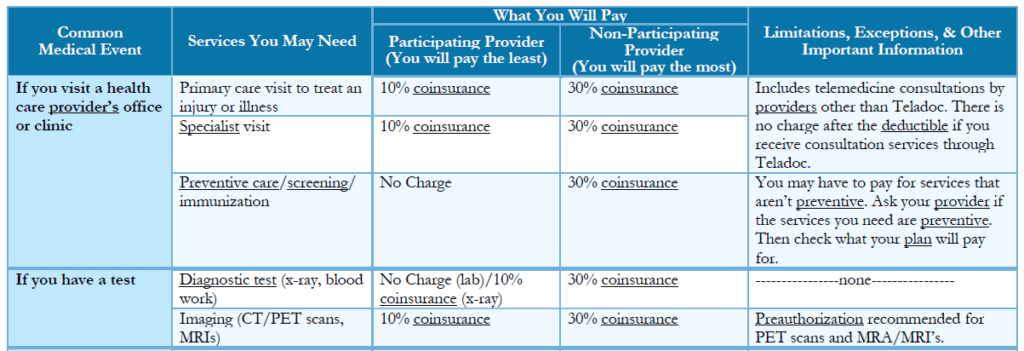

My experience:
I messaged my primary care office through the patient portal, provided a brief description of the injury, and received a call asking to schedule an x-ray and office visit. Knowing my prior history and the unlikelihood for my injury to be a broken bone or the like (something that would show up on an x-ray), I declined the x-ray until being able to speak with my physician to understand if it was truly necessary before I incurred the cost.
Part 2: Primary Care
To optimize the time with our primary care provider and potentially reduce our costs, it can be helpful to do additional research ahead of the appointment. Being able to clearly and succinctly articulate our health concern and any knowledge we have from prior history will hopefully help our provider understand where to go during the visit, thereby saving both parties valuable time. Perhaps one of the lesser known aspects of the US healthcare system is that physicians bill insurance partly based on how much time they spend with the patient, so the more efficient we can make the appointment, the less potential costs we may incur.
Healthcare providers often disparage the use of “Doctor Google,” but given the limited time we have with healthcare professionals in the United States, we should not be dissuaded from leveraging every source of information at our disposal in order to get the proper care. Consider this: providers aren’t able to know every disease and potential treatment, so by doing some preliminary research, it may help guide their care in the right direction, or more quickly rule out what may not be the issue. At worst, advance preparation could help us familiarize with questions or terminology the provider may ask or use, respectively, which could help us answer questions accurately, also saving time.
Ideally, our primary care provider will perform a examination during the visit in an attempt to diagnose our health condition. Asking clarifying questions can help us better understand their thought process and direct any follow-up research on the financial implications. We can also use this opportunity to discuss appropriate tests needed to confirm an initial or suspected diagnosis.
Part 2 Actions:
- Before the appointment
- Research the health condition, noting specific questions to ask and details to clarify, and write a brief description to share with the healthcare provider
- If you’ve experienced a similar health condition before, gather the historical details of that care, such as:
- Provider visits and notes, which can often can be found in your patient portal or by calling your provider’s office
- Site of care (e.g., hospital, urgent care center, etc.)
- Insurance statements, sometimes referred to as “Explanation of Benefits” statements, which explain what charges your health insurance company received from the healthcare provider
- Out of pocket costs (i.e., the expenses you actually paid because your insurance did not)
- During the appointment:
- Ask for the provider’s diagnosis or suspected diagnosis
- Ask about other tests or diagnostics the provider may consider ordering or recommending (e.g., x-ray, MRI, CT scan, etc.)
- Ask which code(s) the provider anticipates using/submitting/billing to insurance. This information can be critical in understanding the potential costs of the appointment or test(s)
- Formally, these are called CPT (Current Procedural Terminology), procedural, or billing codes
- CPT codes represent the encyclopedia of medical services providers use to bill insurance
- Pro tip: we can look up CPT codes and what they represent using various online resources such as CPT Code Lookup, CPT® Codes and Search – Codify by AAPC. Additionally, we can call our health insurance company or use hospital cost estimators to better understand the cost of a specific service using the CPT code.

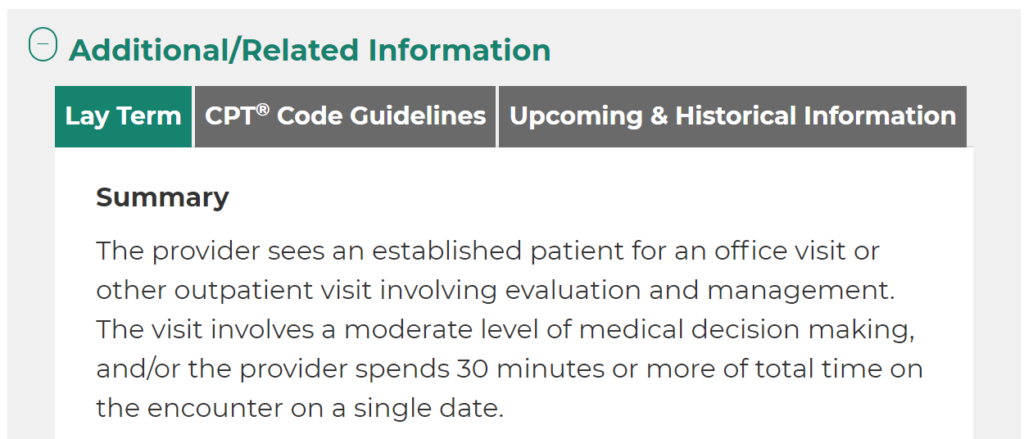
Example search for CPT code 99214
My experience:
After discussing my shoulder pain and past history with my primary care physician, he performed several movement tests to arrive at an initial suspected diagnosis. He also recommended a follow-up visit with a specialist who could provide further confirmation on the diagnosis and treatment options, and reiterated the desire for an x-ray. My physician confirmed x-rays are generally designed to reveal bone fractures and dislocations, which we both agreed I likely did not have. Therefore, I again declined having the test performed pending an appointment and conversation with an orthopedist to understand its true necessity.
Part 3: Referral
Depending on the outcome of the primary care visit, our provider may refer us to a specialist for further evaluation. If you are a savvy and/or experienced user of the US healthcare system with the right health insurance plan, you could theoretically skip right to seeing a specialist rather than first being evaluated by primary care. The process would look the same, but just making an appointment directly with a specialist. Either way, specialists are an additional layer of medical care focusing on specific parts of the body or systems that require more in depth knowledge and training.
In the United States, primary care physicians comprise less than one-third of all physicians3,4 [table 1]. In contrast, specialists collectively represent over two-thirds of all physicians, but they are spread across numerous subspecialties. Thus, there are fewer specialists per person vs. primary care [figure 1.1].
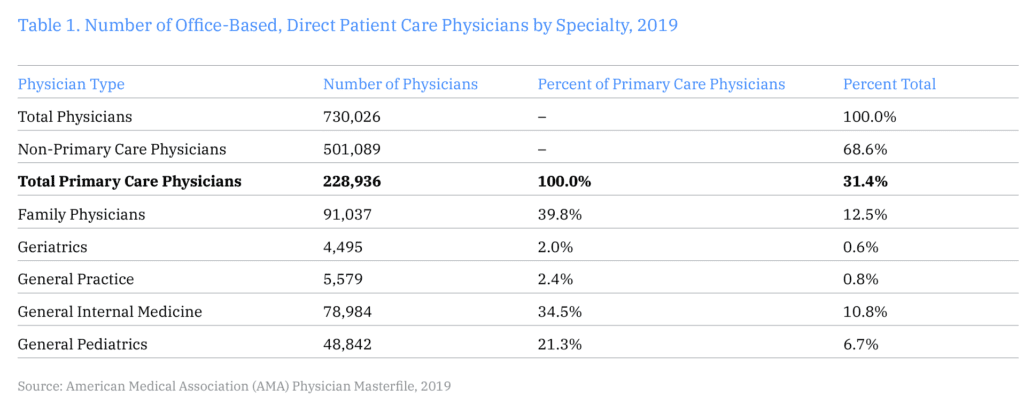
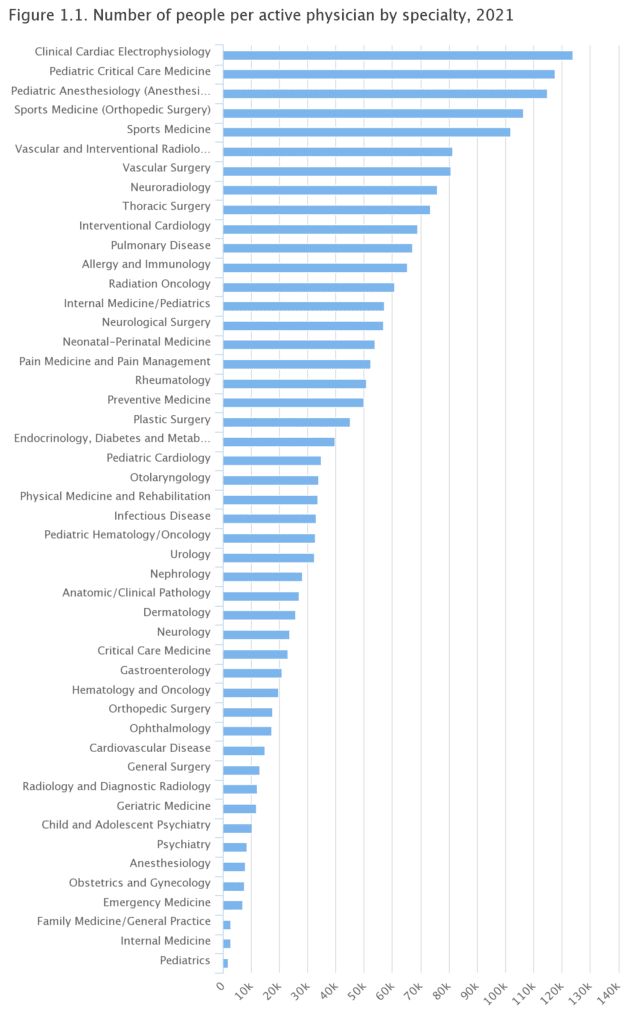
Source: American Medical Association. AMA Physician Masterfile (Dec. 31, 2021).
Population data are from the U.S. Census Bureau, Population Division Release Date: April 2020.
What this means is that when primary care physicians need to refer to a specialist, they may not know of a colleague within that specialty due to their relative scarcity. Moreover, they may not know of a specialist within the same provider or hospital network, which has implications for how much we (the patient) will potentially pay to see that specialist. Therefore, while PCPs may be willing to provide a referral, the referral could end up being outside of our health insurance network, costing us more.
In a similar dynamic to ordering an x-ray, physicians do not bear any financial responsibility of a referral, whether in-network or out-of-network. However, we as patients will likely incur higher costs by seeing an out-of-network provider (see “Non-Participating Provider” columns of the SBC, below). Therefore, to avoid unnecessarily higher bills, we must be aware of the provider network our insurance plan covers.
Figure 1: Summary of Benefits and Coverage (SBC) [excerpt]

If in doubt about whether a provider is in-network, national health insurers like Aetna, BlueCross BlueShield, and Cigna, have tools available on their websites that help patients search for providers within that insurer’s network. Additionally, we can and should call the office of the provider we are looking to see and verify whether the provider is in our insurer’s network and if the provider accepts our insurance.
Part 3 Actions:
- If a referral is recommended or required, inquire whether the physician being referred to is in-network or out-of-network
- If not known, contact your health insurance company or referral physician’s office to verify coverage before attending the appointment.
- Typically, in-network providers are cheaper to see, but if the expertise being sought is hyperspecialized (e.g., a hospital or provider with experience handling a rare health condition), we may have little choice but to accept the higher cost of out-of-network care.
My experience:
In my case, my referral was to orthopedics. Fortunately, my primary care physician was affiliated with a large hospital system with numerous specialties, including orthopedics, so I did not have any issues scheduling with an in-network provider. When I called to make an appointment, the scheduling assistant noted I would need an x-ray prior to the appointment; again, it was important for me to understand why the x-ray was needed prior to the appointment, which was a question the scheduling assistant could not answer. Hence, I declined pending a conversation with the orthopedist.
Part 4: Specialist
From a patient’s perspective, engaging with a specialist is very much the same as with primary care: we must research and come prepared to the appointment to make best use of time. The specialist should have reviewed the notes and background information from our primary care physician, but if not, it is helpful to provide that information clearly and succinctly. From there, the specialist will perform their examination in an attempt to diagnose our condition.
Given the limited number of specialist physicians across the US healthcare system, their time is often more constrained than in primary care. As a result, physician assistants (PAs) are often the first provider within a specialist office we will encounter, but their expertise is generally sufficient to appropriately evaluate, triage, and even prescribe medication if necessary. In fact, PAs must undergo three years of post-graduate education and thousands of hours of clinical rotations to earn a Master’s degree prior to practicing.5 All told, except for the most specific of circumstances, PAs should be just as knowledgeable and equipped to answer our questions as any specialist physician would. Depending on the diagnosis or suspected diagnosis, we should ask the specialist or PA the same questions we asked of primary care, so that we can best understand potential next steps and/or our financial responsibility.
Part 4 Actions:
- During the appointment:
- Ask for the provider’s diagnosis or suspected diagnosis
- Ask about other tests or diagnostics the provider may consider ordering or recommending (e.g., x-ray, MRI, CT scan, etc.)
- Understand the rationale for each test/diagnostic (e.g., an x-ray would seek to rule out bone fractures or dislocations; an MRI would provide a clearer picture of soft tissue injuries that may not be apparent via an x-ray)
- Ask about potential treatment options and their respective implications (e.g., surgery, rehabilitation/physical therapy)
- Ask which code(s) (CPT codes, procedural codes, or billing codes) the provider anticipates using/submitting/billing to insurance
My experience:
My orthopedic PA was caught up on the notes from my primary care appointment, so we didn’t need to spend time reviewing what had already occurred. She performed a brief movement assessment to confirm her suspected diagnosis before explaining potential next steps for treatment, including additional diagnostics and surgery. The orthopedic surgeon she worked with would ask to see the results of both an x-ray and MRI prior to moving forward with any surgical intervention; hence, if I wished to continue receiving care from this provider, I would need to undergo these diagnostic procedures.
Part 5: Diagnostics & Diagnosis
Sometimes, even after several initial assessments, providers may still not be able to render a diagnosis with high confidence and/or will want confirmation of a suspected diagnosis before proceeding with a more significant intervention like surgery. If this is the case, they will likely order additional tests, which may include labs (i.e., blood tests), imaging (e.g., x-ray or MRI), genetic tests, etc.
As mentioned previously, ordering and having a diagnostic test performed typically doesn’t cost anything to the provider. Their primary concern is ensuring they have the necessary information to render a medically accurate and appropriate diagnosis. However, given diagnostics result in a cost to us, the patient, and our health insurance company, both parties have a financial interest in managing the quantity and frequency of diagnostics being ordered. It is a fine balancing act of limiting unnecessary testing but also enabling providers to obtain the medical information needed to perform their jobs.
As patients and consumers in the US healthcare system, shopping around is one of the most powerful ways we can exert influence on how much we pay for healthcare services. It is thus critically important to understand the exact test our provider wants completed, so that we can compare prices across testing companies, hospitals, etc.
Fortunately, there has been legislative and regulatory progress in the United States requiring hospitals and health plans to provide more transparency of medical services costs.6,7 Specifically, every hospital operating in the United States is required to disclose prices for at least 300 services or face potential fines. How individual hospitals fulfill this requirement varies greatly depending on resourcing, but at a high level, this price information is federally mandated to be shared with patients in a consumer-friendly manner. Many large hospital systems have online cost estimator tools that consider your specific insurance coverage and facility to provide a general ballpark cost.8,9 In a few clicks, we can compare the cost of the same procedure performed at different facilities to make the most informed choice.
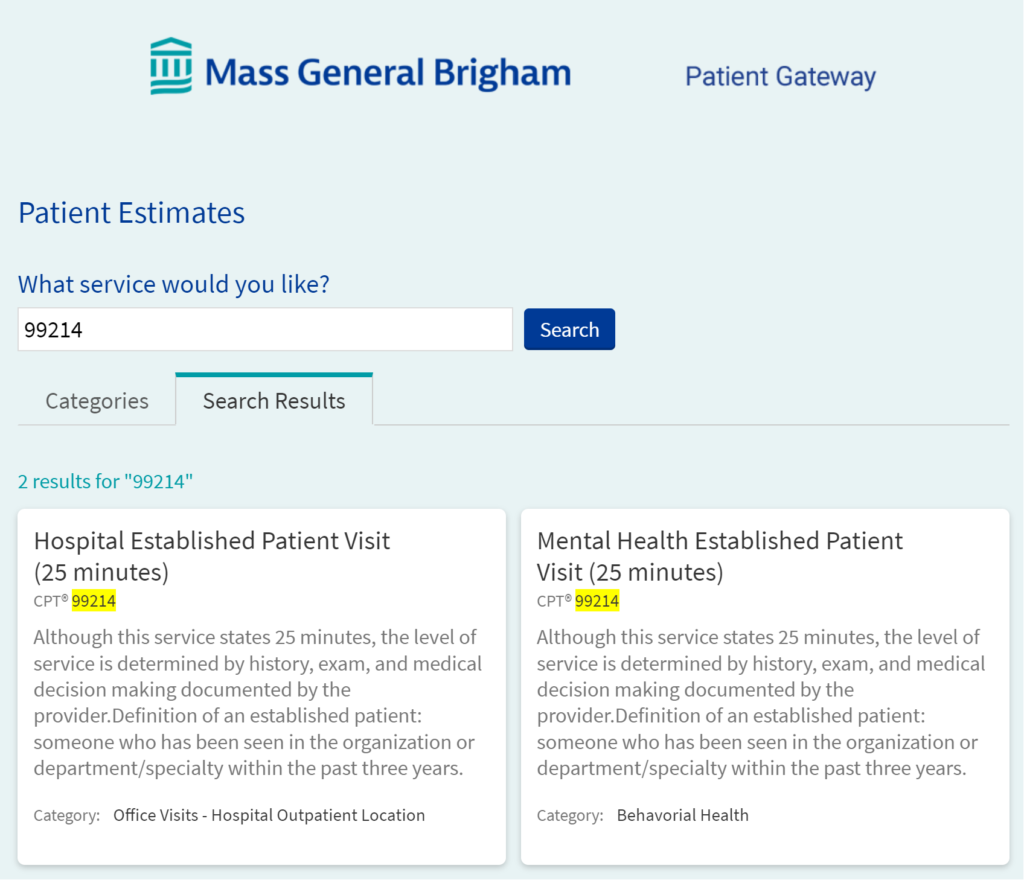
Example search for CPT code 99214 in the Mass General Brigham Patient Cost Estimator Tool
After having the diagnostics performed, our provider should have a better idea or confirmation of the optimal treatment. Follow-up appointments to review test results and discuss next steps can occur either in person or through telehealth.
Part 5 Actions:
- Obtain the exact name of the diagnostic your provider is looking to order (CPT code(s) are ideal, but often these are not readily known)
- Use hospital price transparency tools to shop for the facility that best meets your needs, in terms of price, quality, convenience, and other relevant factors
- Undergo the necessary diagnostic procedures and follow up with your provider to understand next steps
- If next steps include surgery or another major intervention, understand additional needs such as rehabilitation (e.g., physical/occupational therapy, etc.) so you can plan accordingly, physically, emotionally, and financially
My experience:
At the recommendation of my orthopedic PA, I underwent a shoulder x-ray and MRI arthrogram. Prior to undergoing these procedures, I used my hospital network’s online price estimator to understand the potential cost at different hospitals within the network.
Overall, I discovered that an x-ray was significantly cheaper than an MRI arthrogram in absolute terms (roughly 1/10th the price), while the estimated cost of the MRI arthrogram was ~$70 cheaper if I were to have the procedure performed at one facility vs. another. I ultimately decided to have both procedures performed at the facility that was more familiar to me, which just so happened to be the slightly cheaper option.
The final out of pocket bill ended up being 13% higher than the quote from the hospital cost estimator tool. I suspect this was due to the cost estimator tool quoting a standard MRI procedure, whereas in reality mine was somewhat more specialized and included several additional services/charges. Thus, cost estimator tools are exactly that, an estimate, but should provide a general ballpark and more importantly, help compare across facilities.
Nonetheless, after receiving the results of the diagnostics, my care team requested a final follow-up appointment with my orthopedic surgeon to review the findings and discuss treatment options.
Part 6: Treatment
At this stage, we have hopefully received a diagnosis and the next step may be treatment to remedy the ailment. This is likely the most consequential decision to make, both in terms of impact to our health and bank account. Depending on the urgency and nature of the treatment, we may have an opportunity to optimize treatment timing to maximize our insurance benefits. For elective procedures, this can mean significant potential cost savings; however, cost savings should be weighed against the benefit of resolving the issue sooner.
In order to make the most informed decision, consider the following:
- Comfort and Confidence: If you are having a major intervention like surgery, ensure you have full confidence in the provider who will be performing the procedure and/or overseeing the treatment. A few additional follow up appointments to ask clarifying questions, despite the incremental cost, can alleviate a lot of anxiety both leading up to and after the treatment.
- Insurance Coverage: For those of us fortunate enough to have insurance coverage, we may have exhausted most/all of our deductible by this point via office visits and diagnostics. Therefore, depending on the type of plan you have, the high out of pocket costs resulting from treatment may be significantly defrayed, or even eliminated, by insurance. This is why it can be beneficial to accelerate or combine a lot of healthcare utilization into the same calendar year if possible.
- Quality of Life: Quality of life is an intangible but important driver of why we seek healthcare services in the first place. If we are unable to engage in the activities that bring us joy due to our ill health, there is a price to be paid, albeit non-financial. While it may be financially beneficial to defer treatment, in some situations it may be justified and, in fact, necessary to have the treatment performed now to regain full health sooner.
Once we have a perspective around each of these areas, we can confidently move forward with treatment. Similar processes as were used in evaluating facilities for diagnostics can be used to for procedures (hospital transparency tools, etc.). However, at this point we may have developed comfort with the providers and facility we have been visiting thus far, which is an important determining factor that should be weighed in the context of cost.
Pro tip: if you are undergoing the treatment decision process around open enrollment (generally October/November each year), you have the unique opportunity to understand whether keeping your current coverage or switching to a different plan in the subsequent year will be more financially beneficial. However, the risk in switching plans and/or deferring care too long is that provider coverage may change, the new plan or new provider may require the process (i.e., visits, diagnostics, etc.) be performed again, or other complications may arise; not to mention deductibles reset each calendar year. Practically speaking, unless a significant insurance change is anticipated, it is likely easier to proceed with the providers, costs, and facilities we have determined throughout this process, rather than to risk the unknowns of a new insurance plan.
Part 6 Actions:
- Fully understand the procedure/treatment being recommended, including the name and description
- Note: if this is a surgery, oftentimes hospital protocol is to ask the patient multiple times to verbalize what procedure they are having performed before entering the operating room. So, we will have to know it at some point.
- Research your treatment provider(s) (i.e., individuals and facilities), request referrals or other endorsements, or pursue any other avenues needed to gain comfort with the quality of service you’ll receive
- Investigate whether post-treatment services such as physical therapy are available. Many clinics book out far in advance and it may be crucial to begin the rehabilitation process shortly after a procedure (e.g., 2 weeks)
- Enlist support: treatment can throw us into a place we’ve never been before, physically and emotionally. Leverage support networks both pre- and post-treatment to help along the healing process
My Experience:
I had an outpatient (i.e., day) surgery to repair my right shoulder and left the hospital shortly after the procedure. The first several weeks post-operation were extremely challenging due to being in a sling at almost all times and thus unable to use my entire right arm. As any surgical patient can probably attest, it was eye-opening how limited I was in daily activities, though it validated my decision to have the surgery sooner in an attempt to get back to full physical function.
Financially, I had met my deductible prior to the surgery, which significantly reduced my out of pocket costs related to the surgery. However, the procedure was performed late in the year (November), which limited my ability to maximize insurance benefits thereafter. In an ideal world, I would have had the surgery performed much earlier in the year, such that I would be able to consolidate other healthcare services, such as physical therapy, into the same year with little-to-no additional out of pocket cost.
Part 7: Rehabilitation & Long-Term Follow-Up
After undergoing treatment, we may need some form of rehabilitation, defined as care aimed to regain, keep, or improve abilities needed for daily life and beyond. Rehabilitation, or “rehab”, comes in many forms with various connotations, but can include: physical therapy, occupational therapy, speech therapy, respiratory therapy, cognitive rehabilitation, vocational rehabilitation, and so on. Depending on the nature of the treatment, a specific type of rehabilitation may be recommended.
The rehabilitation process can be just as important as the treatment itself to ensure successful long-term outcomes. Typically, the recovery process is long and potentially expensive, which makes it all the more critical to plan ahead if possible to make most use of our insurance benefits. Physical therapy protocols for rotator cuff repairs, knee replacements, or other major surgeries can be 4-6 months or more to full recovery.
For many, rehab often becomes a life-long endeavor (sometimes referred to as prehabilitation or “prehab” in the fitness world), designed to prevent or minimize the risk of re-injury. After injury/illness, we may have to face the reality of not being able to operate at full physical function as we might have in the past. In this way, rehabilitation can be as much an emotional and lifestyle change as it is a physical one.
Part 7 Actions:
- Understand the full scope of your rehabilitation protocol, including duration, to set proper expectations and help plan for the financial implications (e.g., copays, out of pocket expenses, etc.)
- Reference the Summary of Benefits and Coverage (SBC) to understand your rehabilitation benefit (e.g., number of visits per calendar year).
- Often, the benefit isn’t listed in the Summary document. If this is the case, contact your health insurance provider or third party administrator and request the Plan Document or Complete Terms of Coverage (example below). This document should be tens to hundreds of pages that details every healthcare service benefit your plan offers.
- Consider focusing on habits and routines that will help the recovery process feel more normal: gym, bedtime, and waketime schedules, nutrition and diet, social connections, etc. Our fitness, work, and family/home life will probably be upended by treatment, therapy, and the aftermath. Trying to maintain some normalcy in our schedules may make for a more successful and fulfilling recovery process.
Figure: Complete Terms and Coverage document table of contents
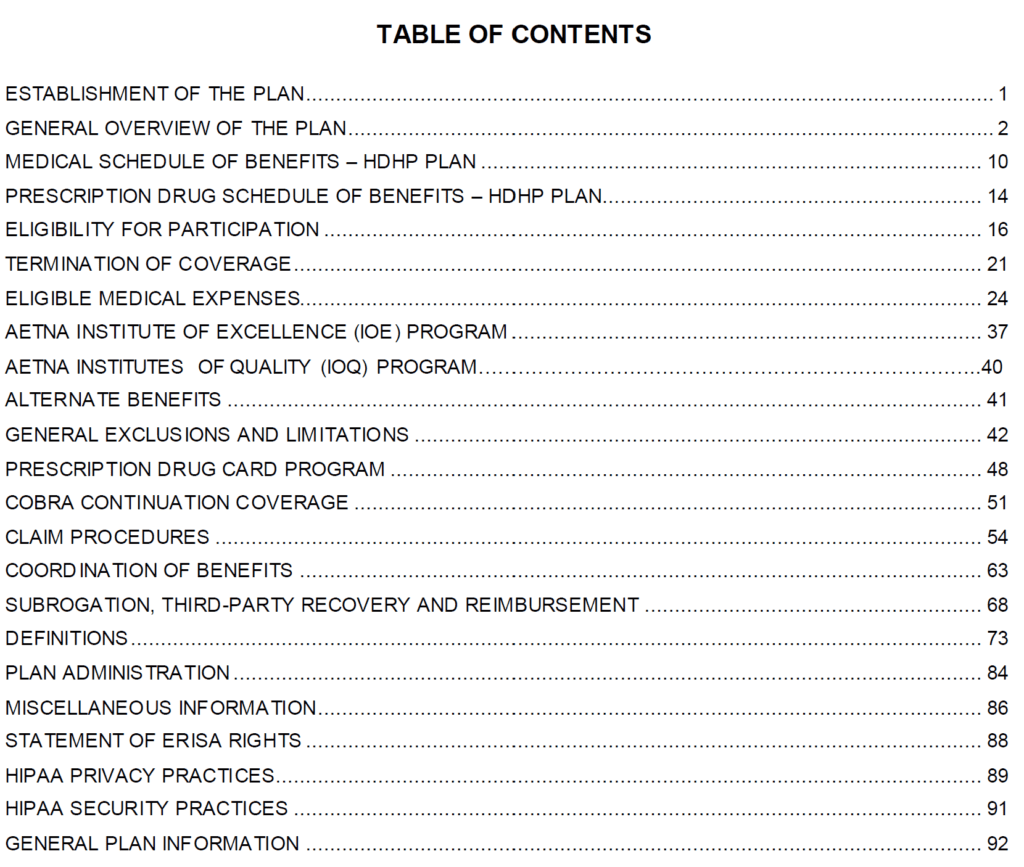
My Experience:
I had two post-operation follow-up appointments to assess the procedure’s outcome and healing process, one at two weeks with my orthopedic PA and one at 6 weeks with my orthopedic surgeon. Between and after these appointments, I was heavily engaged in physical therapy (2-3x/week). Having gone through the physical therapy journey three years ago, my expectations were properly set on the duration of therapy I’d have to endure (3-4 months+). Financially, this was a factor in determining my insurance coverage selection for the subsequent year, in which I opted for a plan with better coverage and supplemented with a flexible spending account (FSA) to help cover out-of-pocket copays.
Knowing the importance of physical health to my mental health, I prioritized adhering to a 2-3x/week gym schedule to walk and perform my physical therapy exercises, which helped maintain my sense of identity as a health-conscious, athletic person, despite feeling far from one. While the recovery process can be non-linear and grueling, it provides an opportunity to reset, be present, and truly take it day-by-day.
Summary
Despite all of the challenges and complexities in navigating the US healthcare system, there is a reason we opted to seek care in the first place: it gives us the best chance of optimizing our health, hopefully for years to come. By going through these experiences, perhaps we gain a better appreciation for the activities we can do, as opposed to those we can’t. Better yet, perhaps we implement positive changes in our life to take better care of our bodies and minds, knowing they can be taken away from us at any moment.
Herein lies the potential silver lining of all the toil that we must endure throughout the treatment journey and from the healthcare system: while it is easy to complain about the frustrations of scheduling appointments, navigating insurance claims, and rehab, the reality is that medicine continues to progress. As such, we have the best opportunity than ever to receive a treatment that gets us back to the life we want.
Hopefully my journey provides a blueprint for how to understand and optimize our use of the US healthcare system and navigate some of the convoluted, arcane set of rules that govern how we obtain the services we need to live our healthiest lives. Equipped with knowledge of our rights as patients and advanced preparation, we can make best use of the System, our providers’ time, and our dollars.
References
- https://www.aamc.org/data-reports/data/2022-physician-specialty-data-report-executive-summary
- https://www.verywellhealth.com/hmo-ppo-epo-pos-whats-the-difference-1738615
- https://www.graham-center.org/content/dam/rgc/documents/publications-reports/reports/PrimaryCareChartbook2021.pdf
- https://www.aamc.org/data-reports/workforce/data/number-people-active-physician-specialty-2021
- https://www.aapa.org/career-central/become-a-pa/
- https://www.cms.gov/newsroom/fact-sheets/hospital-price-transparency-enforcement-updates
- https://www.cms.gov/newsroom/fact-sheets/transparency-coverage-final-rule-fact-sheet-cms-9915-f
- https://www.hopkinsmedicine.org/patient-care/patients-visitors/billing-insurance/cost-estimates
- https://www.massgeneralbrigham.org/en/patient-care/patient-visitor-information/billing/request-cost-estimate
